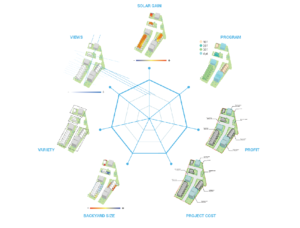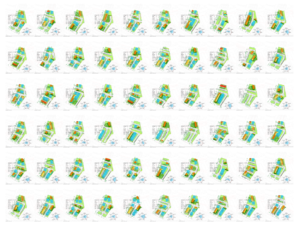By Michael Floyd, AEC Sustainability Strategy, Autodesk.
It’s a well understood conundrum: as projects progress through review cycles and become more detailed, the cost of design changes increases while the potential energy saving benefits from passive strategies decreases. If these passive opportunities like optimizing building orientation, glazing ratio and natural ventilation are not captured early on, they get too complicated and expensive to implement.
Sure, a host of prescriptive energy conservation measures can be applied in later phases of design, but the energy savings inherent to many passive design measures are only available when energy analysis and airflow studies are leveraged early on. Do the analysis upfront when the design is more flexible, or forgo the free efficiency. Of course, historically, “free” has not been free: it has cost time, technical expertise, and effort.
Enter automation.
We are now living in the era of democratized energy analysis. Analytical tools built into BIM design environments, such as Autodesk Insight (part of Revit and FormIt) have made building performance analysis quick, easy, accurate, and accessible to designers with even the most rudimentary understanding of building science. Automating the creation of an energy analytical model and providing the ability to explore the impact of design alternatives with real-time feedback changed the game. But as powerful as such workflows are, they still rely on an iterative process: design, analyze, assess potential changes, and repeat the cycle, moving stepwise towards improved building performance.
What’s the Future of Design?
Computational design is ushering in a new chapter. The Future of Design looks a lot like the transition from iteration to optioneering. Computational design empowers architects to explore vast number of possible design alternatives at once. With this approach, rather than assess one design at a time, architects define design goals and constraints (inputs), and set compute power loose to churn through a multitude of possibilities, leveraging so-called evolutionary algorithms to naturally select towards an optimized subset of design options (outputs). We call this generative design, and it’s going to revolutionize how we pursue high-performance building design.
Generative design
/ gen·er·a·tive de·sign/ noun
A goal-driven approach to design that uses automation to support faster, more informed design decisions.
Generative design promises to turbo-charge architects’ ability to exploit that free energy efficiency available in conceptual massing. Design goals such as “minimize heating and cooling loads,” “maximize spatial daylight autonomy,” and “maximize solar PV potential” will soon go to work alongside goals like “maximize square footage,” “optimize views,” and “minimize cost.” When siting and massing a building, machines can evaluate and explore the complex tradeoffs between such goals infinitely faster and more comprehensively than the human mind ever could. By collaborating with machines, architects can offload this otherwise maddening complexity and focus on more interesting and rewarding tasks.
The result? Designs that respond better to their natural settings: geometries, layouts, and facades that reflect local weather, sun path, and shading from surrounding structures and landscape features. Generative design will help us discover buildings that are more than an answer to the design brief and building program. These buildings will be expressions of the local environment itself.
When will this happen?
It already has. Van Wijnen, a Dutch manufacturer of net-zero affordable housing, leverages generative design for siting and configuration of its “kit-of-parts” prefabricated building system. In partnership with Autodesk, they explored 15,000 possible designs, optimizing across multiple design parameters—including solar gain, views, variety, backyard size, program, profit, and cost—before narrowing the field down to a top three preferred options.
Of course, the potential to automate high performance building design doesn’t stop with energy. Generative design will soon accelerate climate-smart material choices, helping architects and engineers devise buildings with reduced structural mass and minimized embodied carbon.
Scaling the Future of Design
The opportunity is huge, but scaling generative design is going to require another great democratization. Just as energy analysis was once the sole province of specialists and engineers, computational design is itself a specialized practice requiring time, technical expertise, and effort. To that end, Autodesk has created Project Refinery, currently in beta, to open up generative design to more designers.
The other key to scale is ensuring that the industry’s building performance analysis software—originally architected to support an iterative design process—meet the needs of generative workflows. Whether we update existing tools or build them net-new, our analytical toolkit must to evolve to work in a computational design environment. Open source applications like Ladybug and Honeybee, and applications emerging from academia, like Topologic, are pointing the way.


